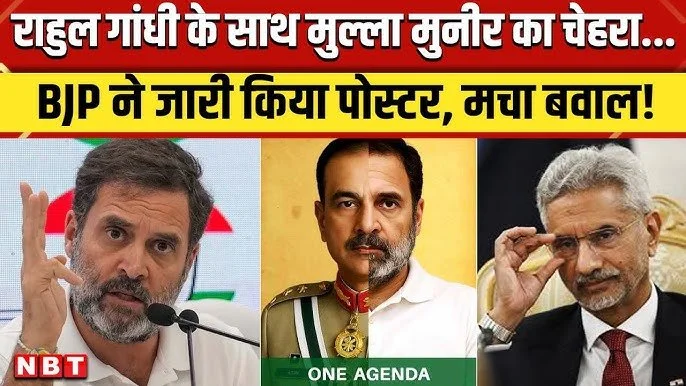From battlefield to backlash: BJP’s war of words and wounds
India reels from military miscalculations and political firestorms as the ruling party targets Rahul Gandhi in an obnoxious attack
SITUATIONER
May 21, 2025
SOMETHING that had seemed inconceivable just a fortnight ago has now unfolded in astonishing fashion. In an act widely regarded as distasteful and unbecoming, India’s ruling Bharatiya Janata Party (BJP) released a controversial graphic, juxtaposing Opposition Leader Rahul Gandhi’s portrait with that of Pakistan’s army chief, Gen Asim Munir.
Why? Gandhi had dared to question actions of External Affairs Minister S. Jaishankar, posing tough queries in the wake of India’s military operations against Pakistan. Chief among them: Was Islamabad informed in advance about the intended targets of Indian Air Force (IAF) strikes? And how many Indian aircraft were lost during the four-day conflict?
In response, the BJP issued two caricatures, insinuating that Gandhi was parroting Pakistan’s stance. One of them mocked: Was he vying for a Nishan-e-Pakistan — the neighbouring country’s highest civilian award? Amit Malviya, a senior BJP figure, labelled Gandhi “the new-age Mir Jafar” on X, posting a meme where Gandhi is seen asking, “How many aircraft did we lose?”, with Prime Minister Shehbaz Sharif urging him to “ask loudly”.
This row, much like others in its wake, underscores growing dissatisfaction among Indian leaders and the public over the outcome of the May 7-10 war between the Indian and Pakistani armed forces. Prior to the hostilities, Indian politicians and public had largely assumed that Pakistan would be swiftly overwhelmed. But that belief was sharply punctured.
Rahul Gandhi (left), S. Jaishankar (right), and the controversial sketch
The robust resistance mounted by Pakistan’s military, combined with an abrupt ceasefire announcement by the US president, caught most Indians off guard. To make matters worse, India’s reluctance to acknowledge the loss of several high-value fighter jets — including the much-vaunted Rafale aircraft — to Pakistani pilots has only deepened the discontent.
Across the border, however, the mood is jubilant. Pakistanis have taken great pride in the spirited performance of their forces. Gen Asim Munir is being elevated to the rank of field marshal, while Air Chief Marshal Zaheer Ahmed Baber Sidhu has had his tenure extended. The Pakistan Air Force pilots, alongside officers and jawans of the army, are being hailed as national heroes. Many believe that had India’s Navy attempted a maritime strike, the Pakistan Navy would have responded in kind.
Earlier this month, as Indian Prime Minister Narendra Modi laid the groundwork for war by accusing Pakistan’s military and intelligence of orchestrating a deadly militant assault in Pahalgam, Delhi appeared better prepared than Islamabad — not just militarily, but politically and economically as well. Pakistan, by contrast, was reeling from a battered economy, as it’s reliant on an IMF bailout, and a fraught political landscape.
Critics had cast doubts over the transparency of last year’s general election, and the country’s most popular political figure, Imran Khan, remains behind bars. Friction between the ruling and opposition parties had seemed insurmountable.
Yet, Modi’s aggressive challenge to Pakistan’s military establishment galvanised national unity. Under the leadership of Prime Minister Shehbaz Sharif and General Asim, the country rallied with unexpected cohesion.
India, by all appearances, enjoyed better circumstances: a larger economy, a more stable democracy since independence, and a military twice the size of Pakistan’s. It was widely believed that any confrontation would end decisively in New Delhi’s favour.
But that is not how events played out. The Modi government’s ambitions were thwarted, and its confidence badly shaken. Although Pakistan may now feel momentarily vindicated, several analysts have warned against complacency. The current ceasefire, described by some Indian officials as a “pause”, may not mark the end of hostilities.
There are growing concerns that India’s ruling coalition, frustrated by its failure to meet strategic objectives, may seek a second opportunity — possibly under a different pretext — to assert its dominance. That’s why some analysts feel that Operation Sindoor is far from over.
